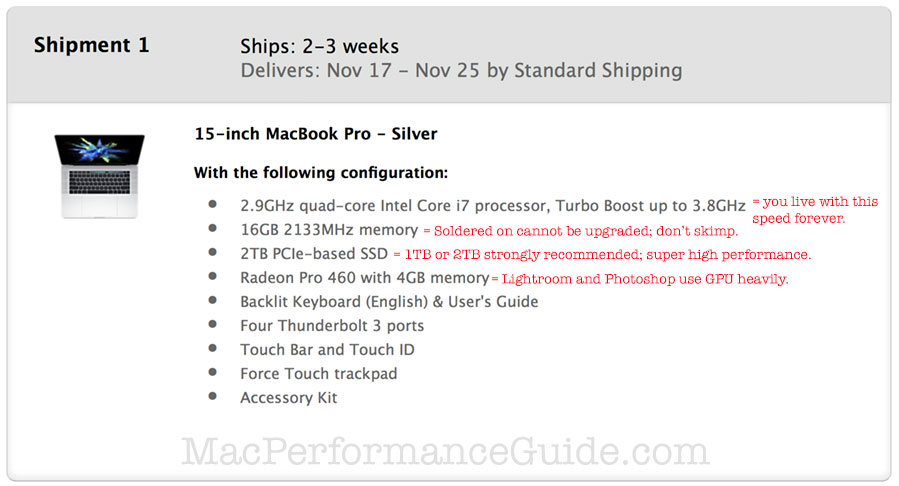2016 MacBook Pro: What Options I Ordered, and Why
See my Mac wish list at B&H Photo and see all 2016 MacBook pro models at B&H Photo. See all 15" Apple MacBook Pro 2016 models or see all 13" Apple MacBook Pro 2016 models. MPG gets credit if you buy through those links.
MPG strongly recommends the 1TB or 2TB flash drive (SSD) option in the 2016 model because there is no way to achieve similar performance externally, at least not yet and maybe never.
This discussion is aimed at professional work and at those who just want the best. Notet that the “best” in a Mac Pro is not so clear-cut, but in a laptop it generally means adding all the options.
What matters, and why?
- Memory on the 2016 MacBook Pro is soldered onto the logic board. No upgrade possibility—ever. So it is foolish to get only 8GB for any kind of professional use (Photoshop, Lightroom, video, etc). While 8GB is fine for web and email browsing and various non-demanding tasks, the rational for a top-end laptop is somewhat at odds with 8GB memory—a MacBook will do just fine for travel and so on. So if there is a real need for a MacBook Pro, 16GB just is the only sensible option.
- The CPU speed is something you experience every day in every app, so the fastest CPU make sense. But the difference is only about 11% and thus hardly noticeable, so if the budget is tight, put the money into 16GB memory and/or larger SSD.
- CPU cores: unless smaller size is of paramount concern (13" vs 15" model), 2 CPU cores (13" model) instead of 4 CPU cores is a very poor tradeoff, particularly with the escalating costs of a large SSD and 16GB memory and GPU upgrade. Ask yourself if saving 5% of the total cost for a slower CPU makes sense—it does not to me.
- The SSD is in theory upgradeable, but that is costly even if (and that’s a big 'if') an upgrade could deliver the unprecedented 3GB/sec that Apple states. That kind of speed is as huge win, so don’t cut it tight on SSD capacity. 512MB must be considered an absolute minimum, but this is likely to prove unwise—go with the 1TB SSD, or 2TB if you like to carry additional stuff around like music or a lot of images and video footage. It saves a lot of hassle when on the road just to have it all there.
- If you’re a Photoshop or Lightroom or video user or a gamer, the GPU upgrade is essential. Photoshop and Lightroom use the GPU increasingly, so this is now just as important as CPU speed in those programs.
- The new Touchbar is hard to speak to; it is cool and nifty, but some users may prefer conventional function keys. Or that touchbar may prove useful over time as software is developed to make sensible use of it. Since the touchbar is omitted only for the starter model, it is not really relevant to this discussion.
In short, there are no real choices if using the MacBook Pro for professional work, except perhaps the 1TB vs 2TB SSD option. You just want a maxed-out 15" MacBook Pro or a maxed-out 13" MacBook Pro. But if the budget is tight and you still want a MacBook Pro and the cost is too high: go with 16GB and the largest SSD you can afford, sticking with the base CPU and base GPU options. You will still have a very find computer.
But wait, there’s more (cost), which raises the total system cost. Total everything up before making decisions above that may prove unwise.
- Budget $200 or so for adapters of various kinds
- $349 or so for AppleCare.
- Backup the MacBook Pro with the Envoy Pro EX 1TB SSD (very compact), or if you’ve chosen the 2TB internal SSD or want lower cost backup, use the Envoy Pro Mini 2TB or 3TB external hard drive. Not quite as small and elegant, but more capacity and much less expensive. Two (2) such backups recommended and never store backups with the laptop!
Don’t forget adapters for compatibility.


 diglloydTools™
diglloydTools™











